Labor law posters are graphics that the federal and local governments require you to display in your business area. These contain information to help your employees understand their rights when it comes to wages, work conditions, and compensation for accidents or unemployment—among other things. Failure to follow labor poster compliance puts you at risk of fines and legal action.
Learn more about what labor law posters are, the required types you’ll need to display, the compliances you’ll have to follow, and each state’s particular requirements.
You can purchase laminated posters or download copies for free from the US Department of Labor (DOL) website (for federal laws) and your state’s DOL site (for state laws.) Then, display them in a conspicuous area for employees to see and you’ve fulfilled your legal requirements.
Labor Law Poster Requirements
In general, your industry, government contractor status, employee headcount, and employee demographics (like age and disability status) determine what federal labor laws you’re subject to and, in turn, what labor law posters you’re required to display. For example, if you employ at least two employees, you’re subject to the Fair Labor Standards Act (FLSA) and must post the Employee’s Rights Under the Fair Labor Standards Act.
Fortunately, the DOL offers a FirstStep Poster Advisor, which asks you a few questions and then tells you which posters you need to display. States also have their own requirements for posters about state laws and programs. Look below for your state’s requirements.
Compliance Note: Workers’ compensation and unemployment benefits information are not generally covered on a federal labor law poster. You’ll need to get these posters from your insurance company or state Department of Labor.
Your employees must be able to read and understand the posters, and many offer multiple language options. However, only the Family and Medical Leave Act (FMLA) requires that you post in multiple languages, depending on your employee demographic.
Common Federally Required Posters (+ Guidelines & Samples)
The most common federally required workplace posters are:
Employee Rights Under the Fair Labor Standards Act (FLSA)*
This poster lists the federal minimum wage, overtime pay, recordkeeping, and youth employment standards for full-time and part-time employees.
Penalties for not posting: Fines up to $211 per violation. Possible debarment from future government contracts.
State and local governments may have higher minimum wages. In those cases, they will require you to post their wage posters as well.
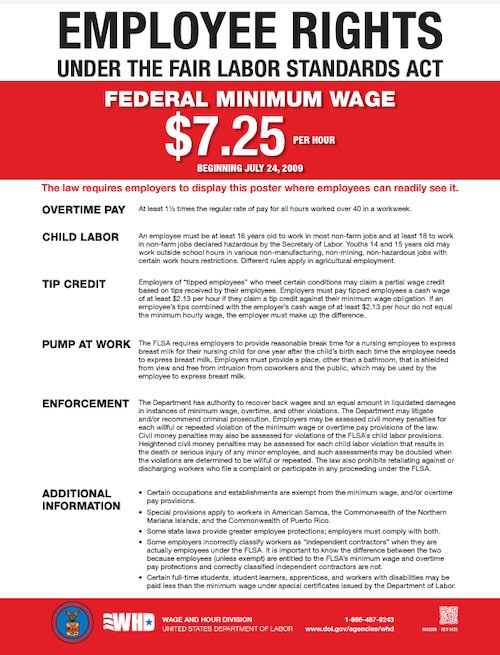
There are several FLSA posters depending on language and industry. Find the right one from the DOL website. (Source: DOL)
Know Your Rights: Workplace Discrimination is Illegal (EEOC)*
In June 2023, this poster replaced all older versions. It summarizes federal antidiscrimination laws and explains how employees can file a complaint.
Poster: The English version must be placed in a conspicuous place. Spanish is available but optional. No specific size is required.
Penalties for not posting: Fines up to $680 for each violation. Possible debarment from future government contracts. Danger of breach of contract if you are a government contractor.
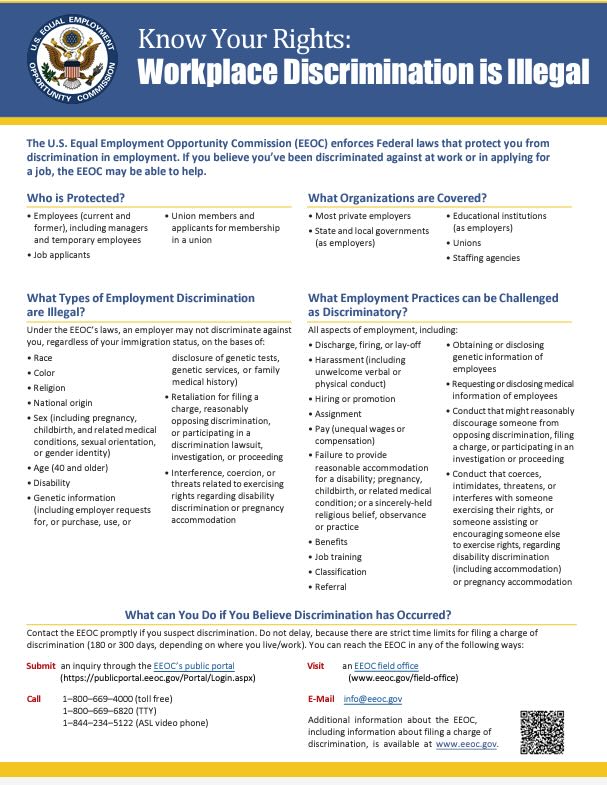
Download this two-page poster from the Department of Labor. (Source: DOL)
Family And Medical Leave Act (FMLA)*
This poster explains FMLA leaves, who is eligible, how to request it, and what employers need to do. It also offers contact information for employees who need to file a complaint.
Poster: The English version must be placed in a conspicuous place. Spanish is available but optional. No specific size is required.
Penalties for not posting: Fines up to $211 per violation. Possible debarment from future government contracts.
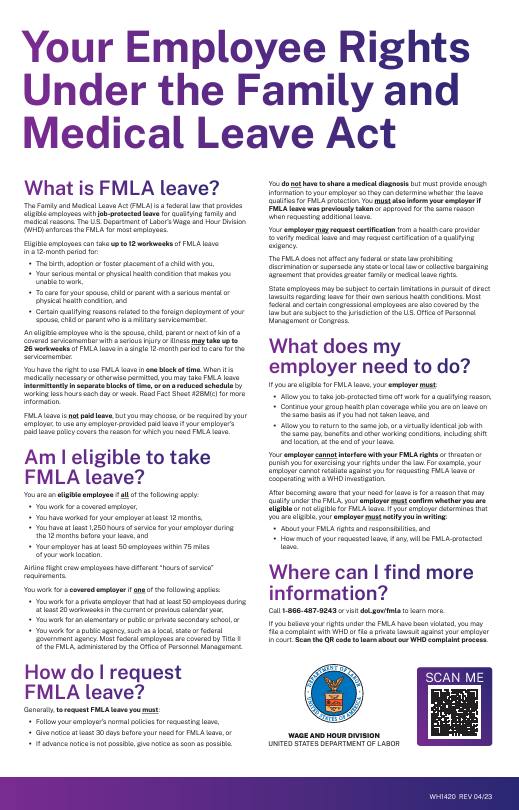
Download the FMLA poster from the DOL website. (Source: DOL)
Uniformed Services Employment & Reemployment Rights Act (USERRA)
This poster explains the rights of military servicemen for re-employment after an absence while serving in the armed forces. It also explains employers cannot discriminate based on military service or obligation.
Poster: The English version must be placed in a conspicuous place. Spanish is available but optional. No specific size is required.
Penalties for not posting: No financial penalties. Possible debarment from future government contracts.
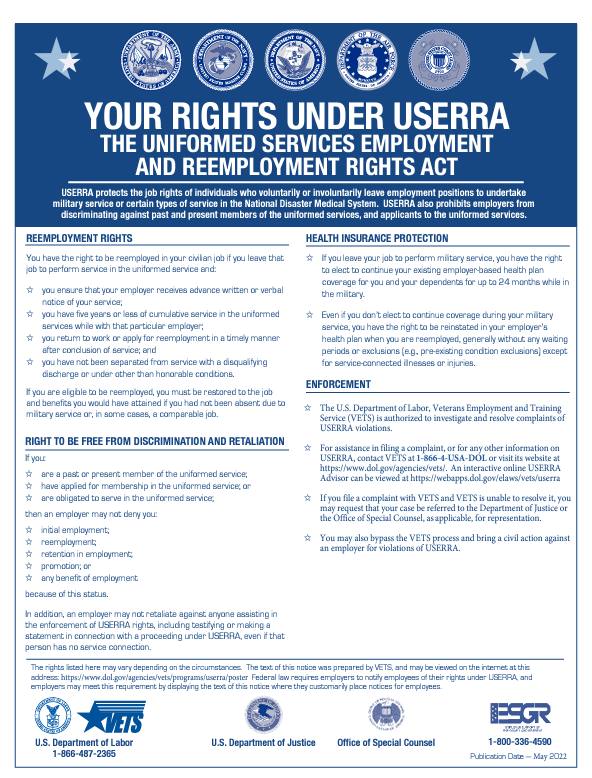
Download this poster from the DOL. (Source: DOL)
Job Safety and Health Protection (OSHA)
OSHA sets health and safety standards for the workplace. The poster includes worker rights, employer responsibilities, and contact information for OSHA. Some states have their own OSHA programs, in which case, you’ll need to post their posters as well.
Poster: The English version must be placed in a conspicuous place. Spanish, Arabic, Cebuano, Chinese, Haitian Creole, Korean, Marshallese, Nepali, Polish, Portuguese, Somali, Swahili, Tagalog, and Vietnamese versions are available but optional. Posters must be at least 8 1/2 by 14 inches with a 10-point type.
In addition, you must post the Summary of Work-related Injuries and Illnesses (Form 300A) in a visible location so that employees are aware of the injuries and illnesses that occur in their workplace. Post this by February 1st of the year following the year covered by the form and keep it posted until April 30th of that year.
Penalties for not posting: Fines up to $16,131 per violation. Possible loss of government contracts.
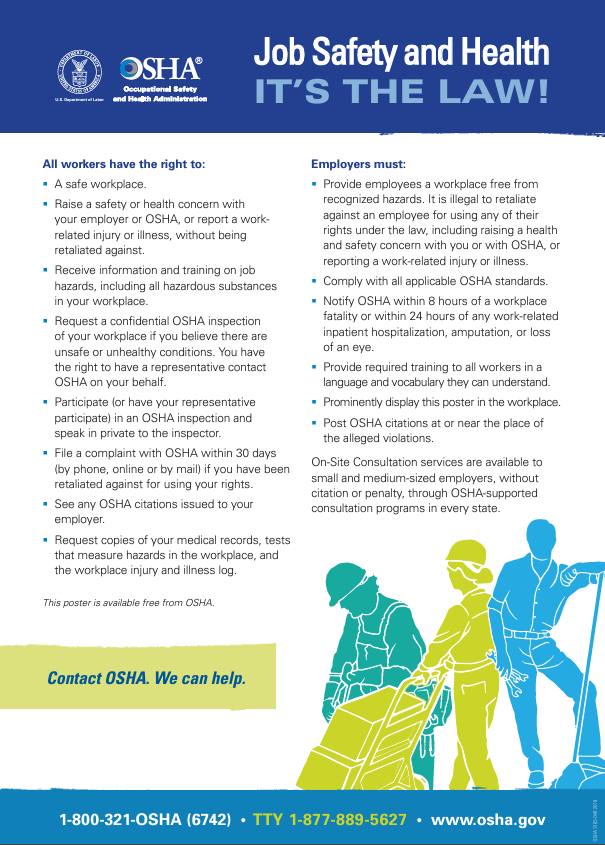
Download the OSHA Poster from the website—there are also language variants available. (Source: OSHA)
Employee Polygraph Protection Act (EPPA)
Explains that with few exceptions, private employers (with few exceptions) cannot use lie detector tests for employment screening or during employment.
Poster: The English version must be placed in a conspicuous place. Spanish is available but optional. No specific size is required.
Penalties for not posting: Fines up to $25,597. Possible debarment from future government contracts.
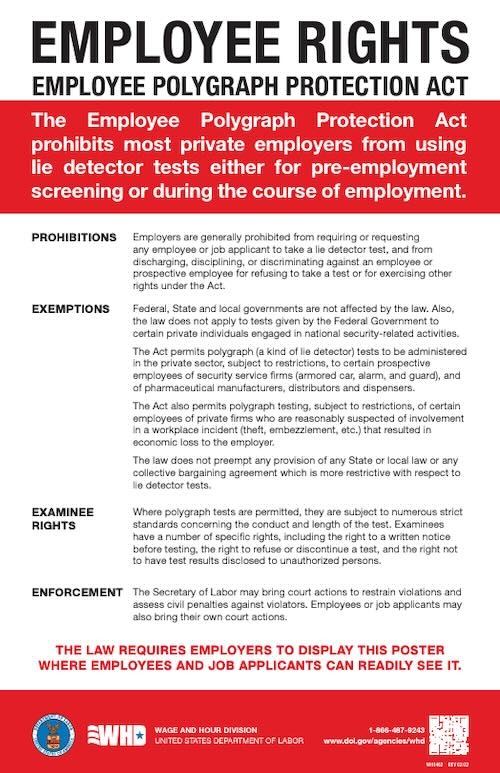
Get this poster from the DOL here. (Source: DOL)
Where Posters Must Be Placed
You have to post these in a place that’s easy for your employees to see and read them. Most companies put their labor law posters in a break room or cafeteria. A great place to put them is near the coffee or water, as most employees frequent those areas of your workplace. Near the bathroom is also a common spot.
If you operate multiple work locations, you have to display your state and federal labor law posters at each location. Also, if your facility is huge, like a warehouse, or separated, like the workshop versus the office, you may need to place posters in more than one spot to stay compliant.
Even though most federally required workplace posters don’t recommend a size, you should avoid shrinking the posters. If the font is not readable, then you may be out of compliance. Some states provide combination posters that have all the state and sometimes federal information needed in a single large poster.
Job Applicant Posting Requirements
Not all posters are for employees only! Some labor law posters, such as the EEOC, FMLA, and EPPA, also need to be posted where potential job applicants can see them. This is just one of the many hiring rules you need to follow.
This gets tricky if you recruit online. To stay compliant, make sure your public job ad states that applicants have rights under federal and state employment laws. You can use language like this:
This company is an Equal Opportunity Employer (EOE). All qualified applicants will receive consideration for employment without regard to race, color, religion, sex, sexual orientation, gender identity, national origin, disability, or status as a protected veteran.
The DOL also says to “place a prominent notice on the website where the job postings are listed stating that ‘Applicants have rights under Federal Employment Laws’ and link to the three posters: Family and Medical Leave Act (FMLA) Poster; Know Your Rights Poster; and Employee Polygraph Protection Act (EPPA) poster.”
When Posters Need to be Updated
It’s best practice to update your compliance posters every year. To stay compliant, labor law posters should be updated whenever the applicable law changes. The federal and state governments will issue a new version of the poster.
Remote Work Posters
Remote employees have the same rights as in-person ones, so you need to make the information found on labor law posters available to them, too. In fact, during the pandemic, the DOL issued updated guidance on compliance posters for hybrid and remote workforces.
Remote employees need to have 24/7 electronic access to the same labor law posters as your in-place employees. This means you can’t just email them the links and files and be done. Your best bet is to post them on a website link, in the employee handbook, or make them available in the cloud through your HRIS employee portal.
For hybrid environments, where you have some employees working fully remote and some who come into a physical workplace, you should display physical labor law posters as normal. But you’ll also need to provide your remote workers with electronic access to the labor law posters.
Which States’ Notices Should I Provide? Since remote employees can work anywhere, it’s often difficult to determine which state labor laws apply. Generally, the state where the employee works governs their employment rights, even if your company headquarters are in another state. So, if an employee lives and works in Florida but for a New York firm, they’ll need access to Florida labor law posters (or the information they contain).
Penalties for Noncompliance
The government can fine you if you don’t post the required workplace posters. While companies are usually only fined for repeated violations, there are situations where you may receive a fine for your first violation, so it’s best to follow the rules from the get-go.
Did you know? The government caps labor law poster noncompliance fines at $42,619. That’s a lot for not putting up a few posters, especially for a small business.
In addition, the government can take away government contracts, ban you from future contracts, and in some cases, cite you for labor law violations. If you are violating a law covered by a poster and don’t have that poster displayed, that adds to your trouble.
There’s also civil law to consider. If an employee can prove posters weren’t adequately displayed, they could file a lawsuit and may receive additional damages because of your company’s non-compliance.
Acquiring Labor Law Posters
You can get labor law posters for free from the DOL and your state’s DOL. They provide links to downloadable files that you can then print and post. Be sure you check if there are any size requirements and remember that they must be easy to read. Many states and the federal government offer combined posters that include all the information. This is a large poster that you may have to print at a shop.
There are services that sell already printed and laminated workplace posters. It may be worth the convenience, but it is not mandatory to use a service like this. In January 2024, the Washington State Attorney General is both suing and prosecuting Labor Law Poster Service for allegedly coercing businesses into buying these posters rather than getting them from the free government sites.
How to recognize a labor law poster scam: Labor law poster scammers work similarly to most scammers but can seem less suspicious because they claim to keep you on the right side of the law. Here’s what to look for:
- Lack of identifying information: There’s no physical address, or the email is suspicious (a Gmail or a strange email that does not match the company).
- Threats: They threaten legal action or to report you if you don’t amend the situation by buying their posters.
- They know too much: They know you just opened for business, they have your (or someone in your company’s) name, or they have information that could be purchased from a marketing list.
- They don’t take “no” for an answer: Repeated follow-up emails, personal mailings, or phone calls are a red flag, especially if they increase the pressure.
- They insist that you have to purchase these posters: They are, in fact, free from the government.
State Labor Law Poster Requirements
In addition to the required federal labor law posters, each state has its own requirements. Click below to see the requirements for your state. Most of these links also lead to places where you can download the posters for free from your state government.
State | Required Notices |
|---|---|
| |
| |
| |
| |
California also has industry-specific poster requirements. | |
| |
There are also posters specific to the mercantile/retail and restaurant/hotel industries. |
State | Required Notices |
|---|---|
| |
| |
| |
| |
| |
| |
| |
| |
|
State | Required Notices |
|---|---|
| |
| |
| |
| |
| |
| |
| |
| |
| |
| |
|
State | Required Notices |
|---|---|
| |
| |
| |
| |
| |
| |
| |
| |
| |
| |
|
State | Required Notices |
|---|---|
| |
| |
| |
| |
| |
| |
| |
| |
| |
| |
| |
| |
|
Labor Law Posters Frequently Asked Questions (FAQs)
Labor law posters are posters that explain federal or state laws concerning aspects of employment, from work hours to minimum wage, and leave policy to workplace safety requirements. They have specific information, direct quotes from the law, and links for more information. You can purchase these from private vendors or download them from government websites.
Yes, if you are subject to the Fair Labor Standards Act’s minimum wage, you must display a compliant labor law poster explaining the act and keep it in a conspicuous place so employees can easily see it.
Businesses with employees are required by federal and state law to post notices explaining their rights under specific labor laws. This is called labor poster compliance.
Yes. If you have remote employees, then you need to make electronic copies of the posters available. You might have them in a file or as an appendix to the electronic employee handbook.
The employer is responsible for ensuring employees know their employment rights. By hanging labor law posters in a place where employees can read them, you make the information readily available. Labor poster compliance is also required by law.
This depends on your state law, but in general, you need to update your required workplace posters every time there’s a change in the law. Regardless, we recommend reviewing your labor posters yearly to ensure compliance.
There’s no specific place that you must place labor law posters. However, wherever you put them, your employees need to be able to see and read them. Break rooms are the most common places, as are bathroom areas.
Yes! According to the Department of Labor, “The FMLA, EEO, and EPPA posters are also required to be placed where they can be seen by applicants for employment.”
Bottom Line
Posting labor law posters for your in-person and remote employees is not only the law, it’s also a service to your people. These posters make it easy for them to understand their rights and the basis of the employer-employee relationship. They’re free to get from the US and state departments of labor and simply need to be posted in a conspicuous area.